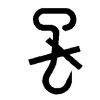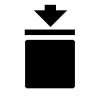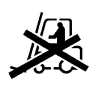Correct and complete marking of packages helps to prevent incorrect handling, accidents, incorrect delivery, losses of weight and volume and Customs fines.
Marking must be clear and precise. Its color should stand out clearly from that of the package; it is usually black in color. Alternatively, it may also be applied on adhesive labels. Where possible, black symbols on a white background should be used. Both when the marking is applied directly onto the package and when adhesive labels are used, care must be taken to ensure that marking is applied in a legible and durable manner.
Adequate marking is an indispensable component of the package. If the marking is at variance with the details on the shipping documents, objections may be raised by the Customs authorities. If handling marking is inadequate, those parties whose actions during transport, handling or storage of the cargo have caused damage may be excluded from liability.
Complete marking must comprise the following three parts:
1. Shipping mark
 |
Identification mark: e.g. initial letters of receiver or shipper or of receiver’s company name |
 |
Identification number: e.g. receiver’s order number |
 |
Total number of items in the complete consignment |
 |
Number of the package in the consignment, e.g. 5/12 or 5 – 12 |
 |
Place and port of destination |
2. Information mark
 |
Country of origin: The country of origin must be stated in accordance with the provisions of the particular countries. Statement of the country of origin is often mandatory. In some cases it is not desired and, if contractually agreed, may even have to be omitted. Failure to comply with such agreements entails a risk of blacklisting. |
 |
Indication of weight of package: from a gross weight of 1000 kg, packages must be marked with details of weight. With regard to ease of transport, handling and storage, the relevant standards also recommend indicating weight from a lower threshold. |
 |
Dimensions of packages: standards specify that dimensions be stated in centimeters. |
3. Handling instructions
„Handling marks“ help to ensure that greater care is taken with cargo handling. It must be possible to tell,
 |
whether the package is sensitive to heat or moisture |
 |
whether it is at risk of breakage |
 |
where the top and bottom are and where the center of gravity is located |
 |
where loading tackle may be slung |
The symbols for package handling instructions are internationally standardized in ISO R/780 (International Organization for Standardization) and in DIN 55 402 (DIN, German Institute for Standardization). The symbols must never be omitted as they are self-explanatory and so overcome language problems in international transport operations.
| Designation |
Symbol |
Explanation |
Fragile, Handle with care
|
 |
The symbol should be applied to easily broken cargoes. Cargoes marked with this symbol should be handled carefully and should never be tipped over or slung. |
Use no hooks
|
 |
Any other kind of point load should also be avoided with cargoes marked with this symbol. The symbol does not automatically prohibit the use of the plate hooks used for handling bagged cargo. |
Top
|
 |
The package must always be transported, handled and stored in such a way that the arrows always point upwards. Rolling, swinging, severe tipping or tumbling or other such handling must be avoided. The cargo need not, however, be stored „on top“. |
Keep away from heat (solar radiation)
|
 |
Compliance with the symbol is best achieved if the cargo is kept under the coolest possible conditions. In any event, it must be kept away from additional sources of heat. It may be appropriate to enquire whether prevailing or anticipated temperatures may be harmful. This label should also be used for goods, such as butter and chocolate, which anybody knows should not be exposed to heat, in order to prevent losses. |
Protect from heat and radioactive sources
|
 |
Stowage as for the preceding symbol. The cargo must additionally be protected from radioactivity. |
Sling here
|
 |
The symbol indicates merely where the cargo should be slung, but not the method of lifting. If the symbols are applied equidistant from the middle or center of gravity, the package will hang level if the slings are of identical length. If this is not the case, the slinging equipment must be shortened on one side. |
Keep dry
|
 |
Cargoes bearing this symbol must be protected from excessive humidity and must accordingly be stored under cover. If particularly large or bulky packages cannot be stored in warehouses or sheds, they must be carefully covered with tarpaulins. |
Center of gravity
|
 |
This symbol is intended to provide a clear indication of the position of the center of gravity. To be meaningful, this symbol should only be used where the center of gravity is not central. The meaning is unambiguous if the symbol is applied onto two upright surfaces at right angles to each other. |
No hand truck here
|
 |
The absence of this symbol on packages amounts to permission to use a hand truck on them. |
Stacking limitation
|
 |
The maximum stacking load must be stated as „… kg max.“. Since such marking is sensible only on packages with little loading capacity, cargo bearing this symbol should be stowed in the uppermost layer. |
Clamp here
|
 |
Stating that the package may be clamped at the indicated point is logically equivalent to a prohibition of clamping anywhere else. |
Temperature limitations
|
 |
According to regulations, the symbol should either be provided with the suffix „…°C“ for a specific temperature or, in the case of a temperature range, with an upper („…°C max.“) and lower („…°C min.“) temperature limit. The corresponding temperatures or temperature limits should also be noted on the consignment note. |
Do not use forklift truck here
|
 |
This symbol should only be applied to the sides where the forklift truck cannot be used. Absence of the symbol on other sides of the package amounts to permission to use forklift trucks on these sides. |
Electrostatic sensitive device
|
 |
Contact with packages bearing this symbol should be avoided at low levels of relative humidity, especially if insulating footwear is being worn or the ground/floor is nonconductive. Low levels of relative humidity must in particular be expected on hot, dry summer days and very cold winter days. |
Do not destroy barrier
|
 |
A barrier layer which is (virtually) impermeable to water vapor and contains desiccants for corrosion protection is located beneath the outer packaging. This protection will be ineffective if the barrier layer is damaged. Since the symbol has not yet been approved by the ISO, puncturing of the outer shell must in particular be avoided for any packages bearing the words „Packed with desiccants“. |
Tear off here
|
 |
This symbol is intended only for the receiver. |
















